Cancer can directly or indirectly arrive in the liver. Cancer that arises directly in the liver is known as primary liver cancer, while cancer that has spread from another site to the liver is known as secondary, or metastatic, cancer. The latter is much more common.
Primary liver cancer can develop as a result of hepatocellular carcinoma, and most primary liver cancer sufferers will have a prior history of liver disease. Primary liver cancer is the world’s third most common cause of cancer death.
Primary liver cancer can be totally asymptomatic, but the most common symptoms that are experienced by sufferers include weight loss, tiredness and pain in the upper right side of the abdomen.
Treatment
Hormone therapy is a widely employed method of treatment. Hormones can both kill and create cancer cells, and this type of therapy focuses on limiting the production of harmful hormones. The therapy might also require the removal of a particular hormonal gland.
Hormones are chemicals produced by glands, such as the ovaries and testicles. Hormones help some types of cancer cells to grow, such as breast cancer and prostate cancer. In other cases, hormones can kill cancer cells, make cancer cells grow more slowly, or stop them from growing. Hormone therapy as a cancer treatment may involve taking medications that interfere with the activity of the hormone or stop the production of the hormones. Hormone therapy may involve surgically removing a gland that is producing the hormones.
The treatment begins with a hormone receptor test, which will effectively decide on the best approach to treatment. If the test proves that hormones are a motivating factor in the spread of cancer, then one of several treatment approaches will be determined. It might prove necessary to prevent the cancer cells from receiving the hormones causing them to grow, or, it might be decided to address the glands that are creating the affecting hormones.
In some cases, it might be required to surgically remove the appropriate glands. Glands that might be removed are those that produce either estrogen or testosterone, namely, the ovaries or testicles. The type of treatment will of course vary according to different factors related to the patient - such as the individual’s age, the type of tumor and the size of the tumor.
- Estrogens are important steroid hormones that are responsible for the control of functions of the female reproductive system, and the development of secondary sexual characteristics. They exert their actions by binding to the estrogen receptors (ERs), activating transcriptional processes and signaling events that control gene expression. In addition to regulation of reproductive physiology and function, they influence cell growth, proliferation, immune response and metabolism.
- The estrogen signaling pathway is a signal transduction pathway composed of estrogen and its related receptors. It has multiple functions such as regulation of reproduction, growth and development, and immunity.
- The most recent study demonstrated that estrogen could regulate the ER?-36/AKT/Foxo3a signal axis to reduce the transcription of related oxidative stress scavenger enzymes and trigger oxidative stress, thereby inducing liver cancer cells to undergo apoptosis. This was the first report of the application of estrogen to HCC cells to induce oxidative stress, an important initial step to further clarify the anti-HCC effect and mechanism of the estrogen signaling pathway.
- In contrast to the multiple studies and different pathways elucidating the protective and preventive roles of the estrogen signaling pathway in liver cancer, some studies have concluded the direct opposite: the estrogen signaling pathway promotes the development of liver cancer. Careful review of these studies reveals the apparent dual role of the estrogen signaling pathway is a function of the different subtypes of the estrogen receptor and the different functional pathways mediated by the spliceosome.
- ER?-36 is a newly discovered non-classical ER? isoform. Compared with nuclear receptors ER?-66, ER?-36 lacks AF-1 and AF-2 transcription activation domains but retains the DNA binding domain and dimerization domain.
- As a selective estrogen receptor modulator (SERM) that competes with estrogen for the ER, tamoxifen was used in a small, prospective controlled trial in 1990 that showed it could be effective in treating unresectable or incurable liver cancer. Only 38 patients with inoperable HCC were included, but the survival time of the tamoxifen-treated group was statistically prolonged with a survival rate at 12 months of 22% (control, 5%). However, a subsequent large randomized controlled trial showed that tamoxifen did not prolong liver cancer patient survival. As an alternative, higher doses of tamoxifen were proposed intending to inhibit HCC in an ER-independent manner.
Medications
Some specialized medications are used during the course of hormone therapy. Tamoxifen is a medication used to reduce the harmful effects of estrogen production, but will not result in a cessation of such production. Men can also be treated with tamoxifen. Other drugs, such as anastrozole and letrozole are capable of causing estrogen production to cease.


















Your thoughts on this
Loading...